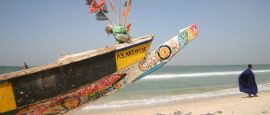Getting around Mauritania
Mauritania Airlines International (www.mauritaniaairlines.mr) is the only airline in the country which does domestic flights. It's possible to charter light aircraft.
Travellers should never attempt any desert journey without a full set of spare parts and essential safety equipment. Travelling in convoy is recommended, and make sure you have plenty of water and fuel.
Driving standards are poor.
There are adequate roads linking Nouakchott with Rosso in the south of the country, Néma in the southeast and Akjoujt in the north. La Route de l'Espoir, a paved highway, runs east from Nouakchott to Mali. All other routes are sand tracks requiring 4-wheel drive vehicles.
In some regions during and after the rainy season roads may become impassable. Similarly, in the dry season tracks can be obscured by drifting sand; a guide is highly recommended, if not essential.
Available in Nouakchott, Nouâdhibou and Atâr. 4-wheel drive vehicles with a driver can be hired and are recommended, but they are expensive.
Taxis are plentiful but expensive in towns (Nouakchott and Nouadhibou). Fares are set, not metered, and a small tip is expected.
There is a line between Nouâdhibou and Zouérat provided by the national mining company, SNIM, to serve the ore mines. Passenger cars are sometimes attached to trains and some passengers ride in empty freight cars; journeys are long and arduous. You need to buy a ticket in advance for the passenger car.
Do you have any Feedback about this page?
© 2025 Columbus Travel Media Ltd. All rights reserved. No part of this site may be reproduced without our written permission, click here for information on Columbus Content Solutions.




 You know where
You know where